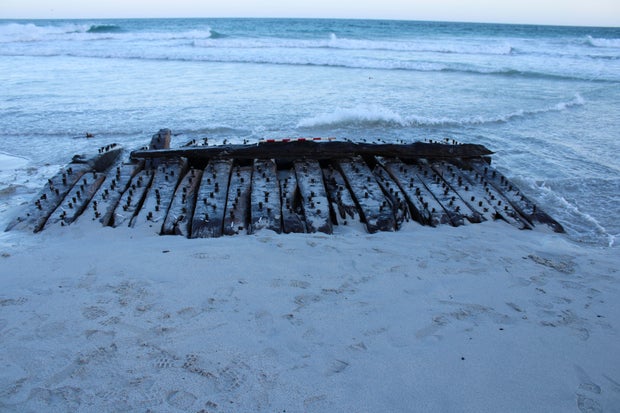Sailor’s break of Scoolboy on Scotland Island identified as Revolung War frigage used for Arctic whales

When school boodboy finds running and finding ribs of a remote Scotland seas, it aroused archaeologists, scientists, and local historians to reveal its issue.
For mixing of high science scientific and social research, they have the answer. Investigators announced on Wednesday that the ark may have been the 18th-century battle, the 18th-century battle that saw an American warfare before the Arctic Life – and was confused.
“I’m looking for you a lucky ship, which is strange to speak on a wrecked ship,” said Beni Saunders, a big seabre archeology, a saucerity that helps community investigators continue to investigate the investigation. The team sent a video about the shipyard at the beginning of Wednesday.
Finions McCarthur / Wessex Archeology with AP
“I think it would be found in many other places, there would be that the desire to recover and study what the content, and the public spirit to do,” said Saunders.
It was revealed after 250 years
The crash was found on February 2024 after the storm was swept across the sand, one of the Orkney islands of Scotland.
As CBS News BBC news class is reported then, Timbers are held together with large wooden pegs, and the local people on the island say they believe that the tailor is discharged from seawater.
Enjoy interest in the island of 500 people, her history is being bound by the sea and its risks. About 270 WHIOWRECKS be recorded on a 20-mile island from the 15th century.
David Walker’s citizen told BBC radio that he was a Buff history and headed straight to the scene to take pictures when he heard the adoption voice.
“My interest made me jump straight to van and the head to look,” she told the BBC Radio Orkney. “Surprisingly, I’m taking many pictures.”
Wessex Archaology with AP
Local farmers used their tractors and trailers to pull 12 tons of Oak Tiners on the beach, before local researchers worked to find it.
“That was really nice, and it was such a wonderful feeling about the community – everyone pulling them up to return,” said Sylvia Thorne, one of the investigators of the island community. “Surely few people are interested in it and be expert.”
On September 2024, a water supply was included in a tank for storing water and study, BBC stories reported.
Dendochrorogy – Dating wooden science from the tree issues – indicated that wood came from the southern England in the middle of the 18th century. That was one privilege, Saunders said, because it meets “point when British bureaucries began to kick” and detailed records are saved.
“So we may begin to check the evidence of the Boboom Sabe we have with the Whells in Orkney,” said Saunders. “It’s a process of completion.
“He removes north of Europe unlike Britain, removing very small wrecks or works outside England and actually in the past, and Earl of Chatham is the last.”
Wars and whaling
Further research found that before Orl of Chatham was not behind HMS Hind, Frigar 24 royal soldiers were built in Chichester on the south coast of England in 1749.
The military work saw a role in expanding – and the choice – the British Empire. The British helped Canada Control in France during the siege of Louisbourg and Quebec in 1750s, and in 1770s a failed Britan’s adherence to its American colonies.
Sold by the NAVY in 1784 and renamed, the ship was a cultivated vessel, hunting large mammals in the Arctic water from Greenland.
The whale oil was an important electricity of the industrial revolution, which is used to rub machinery, tune city cloths and light towns. Saunders said in 1787 there were ships based on London based on the Greenland Sea, Chatham Chatham among them.
After a year, while looking on the whaling ground, it was injured in bad sandy weather. All 56 Crew members survived – additional evidence, Saunders said, that this was a blessed bowl.
Public attempt
The ship logs are stored in a clean tank in a new tank in the Sanday Heritage Center while discussing the program to set you in chronic demonstration.
Saunders say this project is a model of community involvement in Archaology.
“The community is so desperate, so long for them to participate, and they are very proud of them. Good to be seen and protected,” she said.
Local people, it is a link to the past island – and the future. Finding long-term wrewcks may be as often as the climate change transforms air patterns around Britain and verifying the coast.
“One of the biggest things I found outside the project is lasting than Sanday’s past Sanday is always – one community researcher, one community researcher, one community researcher, one community researcher, one community researcher, one community researcher, another researcher, another researcher, Public Works, one public researcher, one public researcher, one public researcher, one public researcher, another public researcher, other public researcher, another public researcher, another community researcher, another community.




